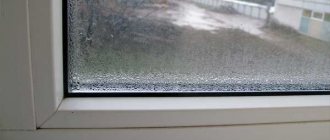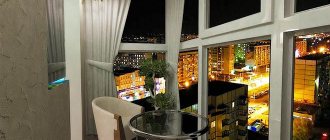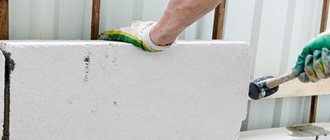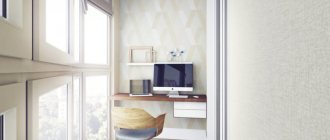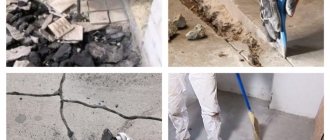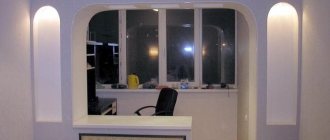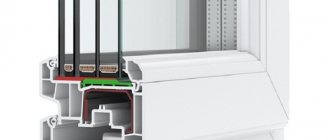In the bustle, we often forget that “you need to prepare a sleigh in the summer.” That is why, with the arrival of cold weather, the question arises - is it possible to order glazing for a balcony or loggia in winter, or is it better to wait for the onset of warm spring days. The question is actually absolutely normal for us, and I can assure you with confidence that installation of plastic windows during the cold period is possible, we do it ourselves very often, because it is profitable to do it in winter, there are discounts from manufacturers, and there is no queue .
Difficulties of glazing in winter
Please pay attention to several points when installing plastic windows on a balcony or loggia in winter.
If you are a resident of an old house, then before replacing windows you will need to prepare for the work. Windows in old houses are usually filled with concrete or plastered up to the hinges, and to dismantle them you will need to work hard to remove them. First of all, dismantle the concrete slopes by cutting them with a chisel or hammer drill and put it all in bags, then release the concrete or wooden window sill from the opening. Buildings built in the 50-80s require more attention, even due to the fact that during dismantling the external slopes, or the inner part of the opening, etc. may fall off. which may require additional work in the future. Why am I focusing on this? The fact is that window dismantling cannot be carried out if there is a pedestrian area or car parking outside the window. Work in such conditions poses a real danger to passers-by: This is why I do not recommend taking risks: it is better to use a special winter protective screen for such work that protects the opening from the street from something falling down, and from the room from the penetration of cold, that is, such a screen does not quickly release heat from the room.
I recommend carrying out work with a protective screen on the windows to a temperature of at least -15 degrees. If it gets colder, it is better to postpone work on installing windows and slopes until the temperature rises.
It is recommended to use a heat shield, because at temperatures below -10 -15 degrees, sealants, PSULs and materials for insulating seams lose their properties, so the temperature will be detrimental to the structure; they will not work in a cold opening as recommended by the manufacturer.
Such an installation using heat shields is more expensive than a conventional one, and if budget is important to you and deadlines are tight, then postpone the installation of plastic profiles at low temperatures. Without a screen, severe frost and high humidity will cause deterioration in the quality of installation seams, so plastic or wooden windows may not last long, and such an installation must be given a greater guarantee.
Disadvantages of installing windows in winter:
- While the work is underway, the apartment will be cool. This is especially true for those who decide to replace old wooden frames in their rooms or kitchen in the cold of winter. However, the speed of the specialists’ work will allow them to complete the installation quickly, so none of the household members will freeze. The thermometer will drop by a maximum of 3-7 degrees. And with normal heating it will recover within an hour.
- The vagaries of the weather will still have to be taken into account: some of the work is unacceptable at temperatures below -15°C.
Overall, replacing windows in winter has more pros than cons.
Insulation and finishing of the loggia in winter
There are different options for finishing a loggia or balcony. Cold glazing only means protecting the perimeter from wind and precipitation. PVC profiles with single-chamber double-glazed windows or cold aluminum are suitable here. On such a balcony you can dry clothes or store out-of-season items.
If you want to make the loggia an additional room, then in addition to the warm double-glazed windows, you need to properly insulate the entire structure. There are many different materials. Foam plastic is used for the floor, penoplex is used for the walls and ceiling. For additional thermal insulation - rolled penofol. The ceiling must be insulated. If there is an open balcony above you, the snow accumulated there will melt and seep down.
The balcony is finished with wooden or plastic lining, MDF panels, clinker tiles, decorative plaster or artificial stone. Laminate, linoleum, and tiles are laid on the floor.
The most serious insulation is needed when the balcony is combined with an apartment. Here you will need energy-efficient windows, installation of heated floors or removal of radiators. Any defects in the glazing will lead to the room being cold and the glass will begin to freeze. Before carrying out a merger, it is necessary to carefully weigh the pros and cons.
Some finishing work can be carried out in winter. For example, replace the windows on the balcony, cover it with clapboard. The main thing is that the tree is dry enough. Otherwise it will crack.
Winter is not an obstacle to welding work. You can strengthen the railings and make a protective canopy. Exterior finishing is also done with siding. It is important here not to work in windy weather, and do not forget about insurance.
Thus, winter glazing, although fraught with some difficulties, definitely has its good sides:
- you can find promotional offers from different companies,
- quick measurement and production,
- elimination of defects immediately after installation.
Advantages of winter glazing
I will list several factors as advantages of glazing in winter:
- The cold season is not popular for installation work, so companies hold promotions and discounts to increase demand. It is possible to purchase high-quality PVC construction from a reliable manufacturer at an affordable price.
- There are not as many orders from companies as in summer and autumn, so you won’t have to wait long for the installers to arrive.
- Quality of work of the installation team: a small number of orders allows the installation teams to slowly complete their work. They have few clients in winter, so each one becomes especially important, no matter how cynical it may seem. And there is time to additionally check the progress of the work, since there will probably be time before the next order.
- Possibility to choose a time convenient for you. Many people mistakenly think winter installation is a bad idea, so they prefer to wait for spring. And you, having understood the advantages, can call a team on a specific date, without asking for time off from work, without asking one of your friends to “watch” in your apartment.
- When glazing in the warm season, everything seems ideal, and inaccuracies (heat leaks and drafts) “pop up” only after a few months, with the onset of cold weather. As a result, you have to contact the company and defend your innocence and seek correction of mistakes. In winter, all installer mistakes are obvious and can appear immediately, and there is nothing bad about that, we are all human, and they can be eliminated directly during installation at the time of delivery of the object, or in the near future.
Winter glazing helps you survive the “harsh time” of the year in warmth and comfort, and not freeze while waiting for spring. Installing plastic window profiles helps you save on energy; now you don’t have to heat the street around the clock, and your money won’t fly out the window. Therefore, immediately think about the possibility of installing insulated double-glazed windows. Even heated double-glazed windows can be installed. This will help achieve maximum comfort in the room.
What to consider when glazing in winter
The technology for installing PVC windows in winter is no different from similar work carried out in summer. However, there are still some nuances; they relate, first of all, to the use of sealants. Not all materials retain their properties at minus degrees and can be used for processing installation seams. You, as a client, do not need to thoroughly understand this issue, but it would be a good idea to ask the contractors what materials they chose for cold temperatures. Do they use winter polyurethane foam for work in winter? Foam can behave differently at different temperatures, which is important to consider when installing windows and slopes in the winter.
Installing plastic windows in an unheated room in winter is specific.
According to GOST (24866-2014), it is unacceptable to install sealed double-glazed windows in rooms where it is below -5°C.
The production and sealing of profiles occurs at positive temperatures. Therefore, when the structure is in the cold, the air inside the chamber is compressed, the so-called concave lens effect appears: the glass bends inward and this can be seen even with the naked eye, it is not beautiful. These features are important to consider, which is why it is necessary to turn to professionals.
know more
You have questions?
Write!
I'm in touch right now!
Roof and canopy
- You should not work in winter with strong gusty winds , since the canopy or roof covering sheets have a large windage. In cold weather, this can cause an accident, since in the cold wind you may not be able to hold the leaf in your hands.
- If it snows, make sure that it does not get between the joints of the canopy or sheets of corrugated sheets . This may affect the tightness of the joints, since frozen tubercles will not make it possible to fit the joints tightly.
Let's dispel myths about glazing in winter
Glazing a balcony in winter, as well as installing PVC windows, is controversial. It is not surprising that various myths have appeared, many of which have nothing to do with reality. I'll tell you how it really is.
Myth No. 1. When installed in winter, the quality of windows may deteriorate.
The season does not matter, everything depends on the qualifications, experience and integrity of the performers. It is in winter that you can immediately check whether everything has been done conscientiously: cracks and heat losses will be immediately visible.
In addition to poor-quality windows, people are concerned about freezing of the apartment and the appearance of drafts. In reality, installing windows involves going through several stages:
- Removing the old frame.
- Surface preparation.
- Installation of a new profile and double-glazed window.
- The final work is the installation of window sills and slopes.
The opening will be open for some time - during the working day, when windows and doors in the living space are closed, the temperature can quickly return to the required parameters. You can even look at the situation in a positive way - the home will be ventilated and the air will be renewed.
Myth No. 2. The profile or glass unit can be damaged during transportation or installation
I agree that this is possible, but it is not related to the winter cold. The appearance of chips, scratches or other defects is possible in the summer. The client is protected from such force majeure: any damage during transportation is covered under warranty. Therefore, if you are worried about the window profile and double-glazed windows, it is in vain.
Important! Delivery of profiles in winter should be made in advance, 1-2 days before the intended installation. It is necessary that during this time the structures, including double-glazed windows, are at room temperature. After this, her window installation will be completely safe.
Myth No. 3. Polyurethane foam is not suitable for work in cold weather
Another misconception is that polyurethane foam cannot be used in winter, because the characteristics of the material lead to a loss of properties in the cold. This is not true: special winter versions of this sealant are available on the construction products market. There are also thermal bags for polyurethane foam that maintain the normal temperature of the material for work. As a rule, installers have either one or the other. So the use of polyurethane foam has long been the best option; the main thing is to make sure that the team you are working with has such equipment.
Popular myths about winter glazing have nothing to do with reality. If you have any doubts, please contact me - I will be happy to help dispel them!
How to insulate a freezing corner or wall?
Buy polystyrene foam or polystyrene foam. Before purchasing, calculate the material consumption, allowing for a reserve of 10%. To install insulation outside the parapet on the second and higher floors, hire high-rise specialists.
- Before laying insulation, clean the wall of debris, old plaster, and remove decorative elements that would interfere with installation.
- When preparing surfaces, treat the walls with an antifungal compound, stain areas with mold, then prime them, just like insulation sheets.
- To fix the insulation, dilute the façade tile adhesive and apply it to the foam. Glue the sheet of heat insulation to the wall, pressing it tightly to the base. Fill the joints between sheets with polyurethane foam. Glue the sickle mesh to the panels.
Note ! You need to cover the wall of both your apartment and the neighboring one with insulation - a small area 50–70 cm wide.
- At the end of the work , apply facade plaster or adhesive for facade tiles to the surface.
Warm installation of windows using a protective screen
To protect against the cold, a protective screen is installed on the street side, which becomes an obstacle to the escape of warm air from the room. The screen is fixed with detachable clamps without drilling. The pneumatic frame located along the contour is filled with air and pressed tightly against the wall of the house. Only after this procedure is the old frame dismantled and replaced with a new one. After installation, the screen is removed.
The design will retain heat and prevent moisture from entering and condensation forming. Warm installation, even in winter, allows you to avoid a decrease in the temperature in the apartment; this method is used in cases where standard installation is impossible.
Glazing in winter is an excellent solution that saves you money and gives a decent result if you abandon prejudices and order glazing at this time of year.
Why does the corner on the balcony freeze?
Freezing is inevitable when the walls are not well insulated and the material from which they are made does not provide reliable thermal protection. Surfaces freeze when heated and then cool with the formation of condensation.
In Soviet-built apartment buildings, loggias and balconies were not glazed; the walls were designed for street heat loss. By covering the loggia in the Khrushchev building, the homeowner creates a street environment here. Warm room air does not pass through it, but cold air from the street cools it down. As a result, the temperature in the building drops to the street level. Until it stabilizes, the temperature in the room is slightly higher than the outside temperature. At this moment, dew appears on the wall. Freezing later as the temperature drops, it turns into frost.
In panel houses, dew drops on the walls occur due to poor-quality heating or insulation, when moisture condenses at the border of cold and heat. The problem is solved by insulating the room from the outside or increasing the heating temperature.
Walls in contact with the outside environment cannot be insulated inside. This will only shift the dew point behind the insulation. Drops of moisture will not cover the wall, but the insulating material itself. The consequence may be the spread of fungus and mold.
Winter glazing of the balcony
The onset of cold weather is by no means a reason to abandon the balcony glazing project. Moreover, installation of windows in winter is possible and is no different from summer. Snow and frost will not affect the quality of glazing, but only if it is carried out by conscientious craftsmen who know their business inside and out.
The plastic used in profiles becomes more fragile at sub-zero temperatures and is easily damaged. Therefore, structures are delivered to the site at least one day before installation. At the time of installation they are at room temperature. The material cools at a rate of 1 degree/hour. This condition allows for high-quality installation even in cold weather.
Installation of windows or glazing of a balcony cannot be carried out at temperatures below -20°C. But it’s even better if the thermometer reads – 5-10°C.
The temperature on the balcony in winter with cold glazing will be almost the same as outside the window, so you can only use this area as a storage room or for drying clothes. If your goal is to make the balcony a living space, choose a warm glazing option with the installation of a heater, then the temperature regime will be almost the same as in the apartment.
How to prevent corner freezing?
Freezing can be prevented during the construction and renovation of a building. The temperature inside the corner is lower than the temperature of the walls that form it. To reduce temperature differences by up to 30%, corners should be rounded or chamfered on the inside using insulating plaster or wall material. Installing pilasters on the outer corners of the house has a similar effect.
Another way to increase the temperature near the corner joints is to install a homemade “plafond” made of gypsum fiber board with incandescent lamps under it in the ceiling. As the lamps heat up, they will push the dew point deeper into the wall.
Now you know what to do when the corners of your apartment freeze and you can insulate the loggia yourself, saving on the services of contractors.
Don’t want to waste time and are looking for professional installers? Contact . Our specialists professionally insulate, glaze and finish balconies and loggias. Only certified materials are used in the work. All types of work are provided with a quality guarantee.
Winter glazing of the loggia
Installing plastic windows on loggias in winter is also not difficult. At the same time, think about insulation to turn the loggia into a living space - a living room, a study, even a nursery or bedroom. This extension will gain a key advantage if you choose warm glazing. Together with insulation, it will help to achieve a comfortable temperature on the loggia, which will be almost the same as in the heated part of the house.
Winter glazing of a loggia is no different from similar work in summer; it can be done quickly and efficiently.
Budget balcony with your own hands - insulate the walls
The algorithm for thermal insulation of walls is quite simple. For a budget option for insulation, you can use polystyrene foam, which has an affordable price.
To ensure installation quality, check:
- flatness of the base;
- no protruding reinforcement;
- reliable sealing of cracks.
Sequence of operations:
- Keep the surface clean.
- Waterproof your walls.
- Cut the insulation.
- Glue it with minimal gaps.
- Install the fixing elements.
High-quality thermal insulation of walls helps ensure a comfortable temperature.

